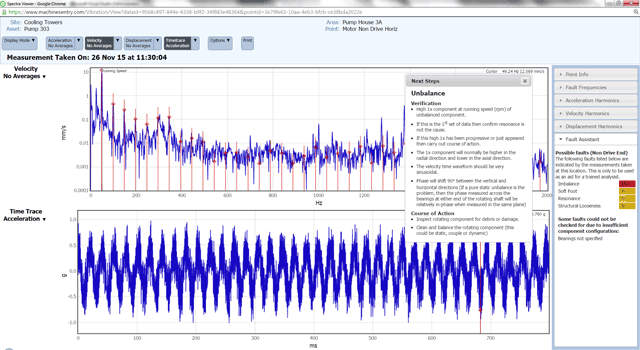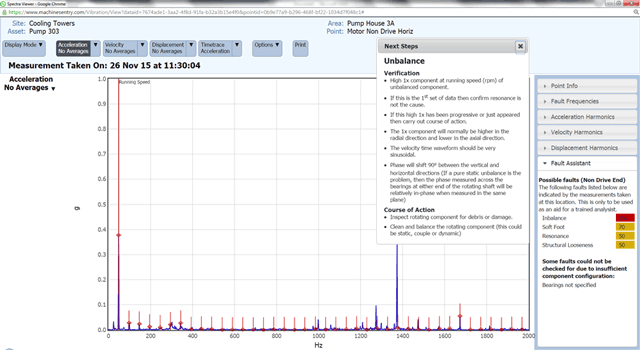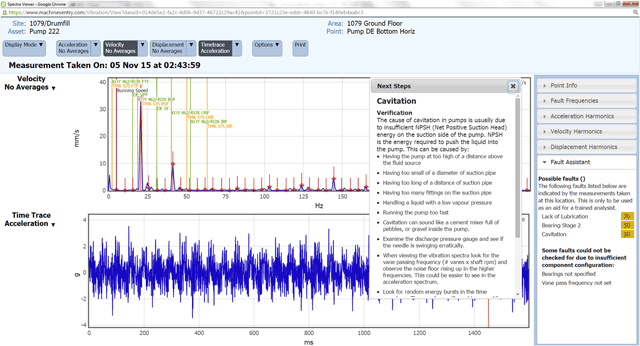
Automatic fault diagnosis can reduce the time, cost and skills needed to detect and deal with vibration problems before they become critical. Lee McFarlane, technical director for asset management at AVT Reliability, explains how.
Vibration analysis should form a central part of any reliability programme, yet it is still considered a black art in many industries – and a costly and time-consuming one at that.
There’s good reason for this. The potential faults indicated by excess vibration are numerous and can indicate anything from easily remedied misalignment or the need to replace a rolling bearing, to complex issues such as rotor bar conditions or soft foot (movement or distortion of a machine frame caused by its feet being at different levels).
A dedicated on-site vibration engineer who can analyse data and make informed decisions that prevent faults developing into equipment failure is a highly valuable asset to any reliability team. However, financial constraints can mean that to have such expertise on the staff roster often remains the preserve of bigger industries such as oil and gas or petrochemicals.
For companies where unscheduled downtime would be equally disastrous, but which have tight financial margins that don’t stretch to having a qualified vibration analyst permanently on site, this can be a problem, especially as outsourcing vibration analysis to external specialists can prove almost as costly.

The answer could lie in automatic fault diagnosis – an algorithm-based approach to vibration monitoring and analysis which offers both simplicity of use and cost-efficiency. An example of this is the Machine Sentry web hosted condition monitoring system.
A triaxial sensor is attached to a piece of rotating equipment and is connected to the software via a handheld android phone or tablet using standard Bluetooth wireless technology.
Continuous monitoring and visibility on three axes means there’s no risk of faults going undetected. And replacing a traditional wired accelerometer with wireless technology means that data can be collected from a distance of more than 50m – making it safe and easy to collect even from large, moving or hard-to-access machinery.
But the primary feature of the technology is its automatic diagnostic assistant (ADA). This algorithm, built on a heritage of vibration analysis, is able to analyse the data as soon as it is collected and suggest what action maintenance engineers should take to confirm precisely what the problem is, and remedy it.
Informed by thousands of hours of vibration data coupled with the extensive field experience of vibration specialists, ADA can automatically detect and report on 22 common conditions which have the potential to reduce machine reliability or even bring production to a standstill.
These include unbalance (couple, static, dynamic and overhung); a bent shaft; resonance; parallel, angular, or complex misalignment; cocked bearings; and structural or rotating looseness. The system can also detect soft foot; blade or vane pass issues and cavitation in pumps; and even a lack of lubrication. For gears it will recognise misalignment, backlash and eccentricity, a broken tooth or tooth wear, and for bearings it can distinguish failure stages 2, 3, or 4.

ADA will either pinpoint the most likely problem, or present up to four potential points of failure ranked in order of greatest likelihood, and outline the next steps to take. This could be anything from cleaning and rebalancing a rotating component, to structural looseness.
A traffic light system, where green means no issue is detected, rising to amber and red where problems are identified, bridges the skills gap so any maintenance engineer can use automatic fault diagnosis.
Budget implications are an obvious concern for any responsible reliability manager but it’s worth considering the immediate cost savings offered by algorithms like ADA.
It takes two years of training and experience to develop a vibration analyst, and two hours for an experienced vibration analyst to evaluate data and make an informed decision. With automatic diagnosis, there is no need to outsource data analysis and preventive maintenance can lead to long-term savings
A 1997 benchmarking study concluded that for every £1 spent on automatic fault diagnosis technology, at least £5 is saved in terms of time, expertise and hardware and software costs. Over a three-year period there is an estimated increased uptime of 33%, parts are reduced by 23% and labour costs reduced 16%. All these will be compelling arguments for any company with a close eye on reliability and the bottom line.

